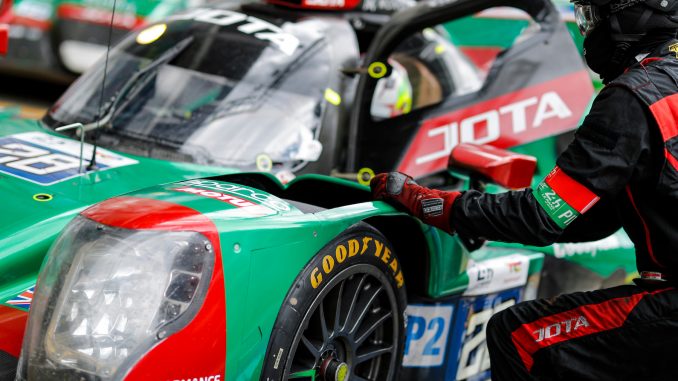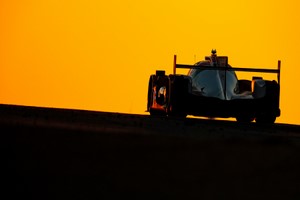
– LMP2 cars set new standards for reliability and performance at the 24 Hours of Le Mans.
– Teams travelled further compared to races 10 years ago while using less fuel and fewer tyres.
– Three weeks after Le Mans, the FIA World Endurance Championship resumes at Monza.
Last month, the 24 Hours of Le Mans delivered impressive results for Goodyear and the LMP2 category. 26 out of the 27 cars that started the race finished, and teams achieved unprecedented tyre mileage.
After a three-week break, the FIA World Endurance Championship arrives in Italy for the 6 Hours of Monza, a circuit with similar characteristics to Le Mans, with high average speeds and technical chicanes. At Le Mans, track temperatures ranged from 17-43 degrees celsius throughout the race. While the climate is similar to Le Mans, Monza’s track surface absorbs less heat, which will provide setup engineers with a different challenge.
Quadruple stints have become commonplace, forcing teams to think about how to get the most from their cars while being as efficient as possible. During Le Mans, both United Autosports and the Nielsen Racing cars managed five stints on a set of tyres during the night without experiencing any extreme degradation. This equates to up to 750 kilometres on a single set of tyres. Jota and Prema both completed 369 laps of the 13.6-kilometre circuit, meaning more than 16 Formula 1 race distances were covered with just 12 sets of tyres.
The data from Le Mans is a testament to the speed and reliability of the category, with distances between tyre stops changing the way endurance races are played out strategically.
Relentless development without breaking the bank
25 years ago, Tom Kristensen, Michele Alboreto and Stefan Johansson took their Porsche WSC-95 to Le Mans glory. It was one of two cars built, with the sole objective of harnessing the most cutting-edge technologies of its time to achieve victory at Le Mans. Goodyear brought special tyres for qualifying and a range of possible race compounds, and teams could achieve a maximum of two fuel stints per tyre change. It showcased innovation and ambition in an era of bottomless manufacturer budgets.
In comparison, in 2022, Roberto Gonzalez, Antonio Felix Da Costa and Will Stevens took the LMP2 win for Jota. Its Oreca 07-Gibson had less power than the Porsche WSC-95, a single dry specification of Goodyear tyre giving versatile performance whatever the temperature, and a private team, rather than manufacturer level, budget. They went 60 km further in 24 hours than the Porsche, on less fuel, fewer tyres and a fraction of the cost.
LMP2 pace and durability have progressed rapidly in the past decade. In 2012, the race-winning Starworks-Zytek team covered 585 fewer kilometres than this year’s Jota in a race where only 12 of the 20 starters made it to the chequered flag.

PHOTO CLEMENT MARIN
LMP2 showcases a mix of spectacular performance and efficiency
The magic of LMP2 is that it mixes sustainability with stunning pace and bulletproof reliability. LMP2 Le Mans pole was a mere 1.95% slower than the Toyota GR010 Hybrid which took the Hypercar category pole. This is particularly impressive considering that LMP2 cars can carry no more than 75 litres of fuel. Furthermore, LMP2 cars are restricted by the amount of air they can channel through the engine. This means teams face an extreme intellectual challenge to find new ways to go faster and further, and tyre strategy plays a significant role in eking out every last bit of performance.
The same pursuit for efficiency and performance makes endurance racing relevant for Goodyear’s road tyre development. For example, the company’s latest Eagle F1 Asymmetric 6 combines a step forward in grip but also energy-saving rolling resistance versus its predecessor. This is an example of where philosophies in endurance racing and road tyre development complement each other.
Mike McGregor, Goodyear Endurance Programme Manager, explains: « The success of LMP2 can be put down to how high the bar is across the entire category. Compared to a decade ago, teams have doubled in size and many of the operations rival that of the Hypercar class when it comes to execution and attention to detail. How the teams interact and collaborate with Goodyear is equally impressive. In the garages, a Goodyear track support engineer is assigned to each team to extract the most out of the package. All of this adds up to cars that are still mighty through sections such as the Porsche Curves or Monza’s Parabolica, despite being slowed down in recent years by regulation. The category is a testament to how the ACO and FIA have developed and supported endurance racing.
« The regulations bring out the best in chassis, fuel and engine suppliers to deliver performance and reliability and make it a perfect test bed for Goodyear. We are proud to deliver relentless performance sustainably, reducing the number of tyre specifications by increasing tyre versatility.
« Ten years ago, a quadruple stint was a rarity. Now, it is the norm. The most successful teams optimised the latest Goodyear’s enduring performance to maximise the tyre mileage and reduce valuable time wasted changing tyres in the pits. »
James Bailey,
